
Causal AI Market
Causal AI Market by Offering (Causal AI Platforms, Causal Discovery, Causal Inference, Causal Modelling, Root Cause Analysis), Application (Financial Management, Sales & Customer Management, Operations & Supply Chain Management) - Global Forecast to 2030




OVERVIEW
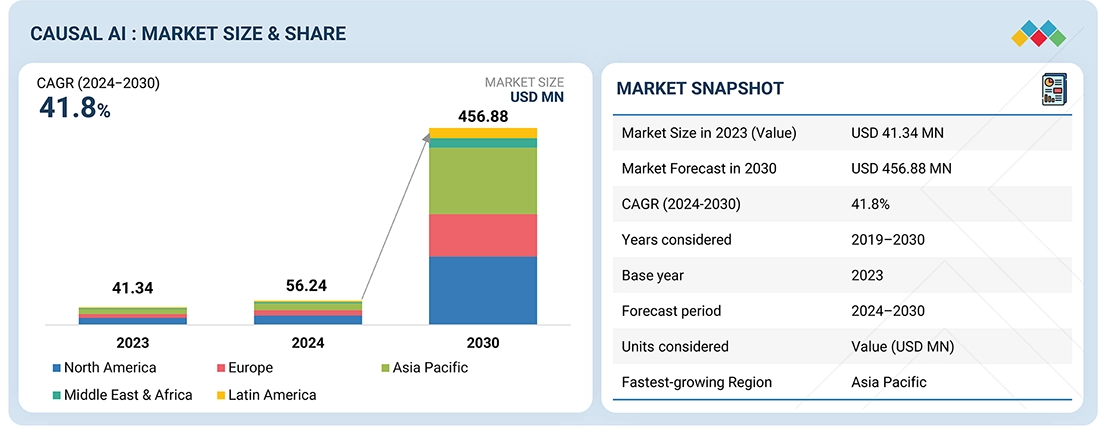
Source: Secondary Research, Interviews with Experts, MarketsandMarkets Analysis
The Causal AI market is projected to grow from USD 56.24 million in 2024 to USD 456.88 million by 2030, at a CAGR of 41.8%, reflecting a major shift toward explainable, transparent, and outcome-driven AI systems. Unlike traditional machine learning models that operate as opaque “black boxes,” Causal AI enables organizations to understand cause-and-effect relationships—answering why something happens and how outcomes can be influenced. This capability is becoming essential in Healthcare for Enhancing treatment strategies through causal inference, Finance for Improving fraud detection and risk modeling with transparent logic, Marketing for Driving personalized engagement based on individual user behavior, Supply Chain & Operations for Optimizing complex systems with predictive causal models. The rise of AI regulations such as GDPR and the EU AI Act is accelerating adoption, as causal models support Transparency, Accountability, and Auditable decision-making. This makes Causal AI particularly valuable in regulated industries where trust and compliance are non-negotiable. Vendors are embedding causal modeling into Decision intelligence platforms, Predictive analytics tools, and AI governance frameworks. Buyers are seeking solutions that offer Explainable AI (XAI) capabilities, Regulatory-ready decision support, Personalization engines powered by causal inference, and Forecasting tools with intervention modeling.
KEY TAKEAWAYS
-
BY REGIONNorth America is estimated to account for the largest share of 38.92% of the global causal AI market in 2024.
-
BY SOFTWARECausal AI platforms dominate the market,growing at a CAGR of 43.7%.
-
BY SERVICESTraining, support & maintenance services is the fastest-growing sub-segment, with a CAGR of 47.1% during the forecast period
-
BY APPLICATIONBy application, Marketing & pricing management is anticipated to grow at the fastest rate during the forecast period.
-
BY VERTICALThe Banking, Financial Services & Insurance (BFSI) sector holds the market share by vertical.
-
COMPETITIVE LANDSCAPE-Key PlayersVendors are scaling through Platform innovation, Strategic partnerships, Domain-specific solution development. Key players include Causaliens, DataRobot, IBM. These companies are focused on building real-time, scalable causal inference engines tailored to enterprise needs.
-
COMPETITIVE LANDSCAPE-StartupsParabole.AI, Howso, and Incrmntal have distinguished themselves among startups and SMEs through robust product portfolios and effective business strategies.
The Causal AI market is experiencing rapid growth, driven by enterprise demand for Explainable analytics, Outcome-driven decision intelligence, and Scalable predictive modeling. Vendors are embedding causal inference platforms across key business functions—from risk modeling and operational optimization to scenario planning and strategic decision support—to deliver transparent, actionable insights.
TRENDS & DISRUPTIONS IMPACTING CUSTOMERS' CUSTOMERS
The Causal AI market is rapidly evolving, fueled by advancements in causal inference algorithms, decision intelligence platforms, and predictive analytics. Traditional analytics solutions often rely on correlation-based insights, but organizations increasingly demand outcome-driven, explainable AI models to guide critical decisions. This shift is transforming revenue approaches, with enterprises adopting performance-based AI solutions that optimize business outcomes while reducing implementation risk. Causal AI platforms enable scenario modeling, risk prediction, and personalized decision strategies, moving beyond static analytics. These trends position causal AI vendors as strategic partners, delivering actionable, data-driven insights that enhance operational efficiency and decision-making at scale.
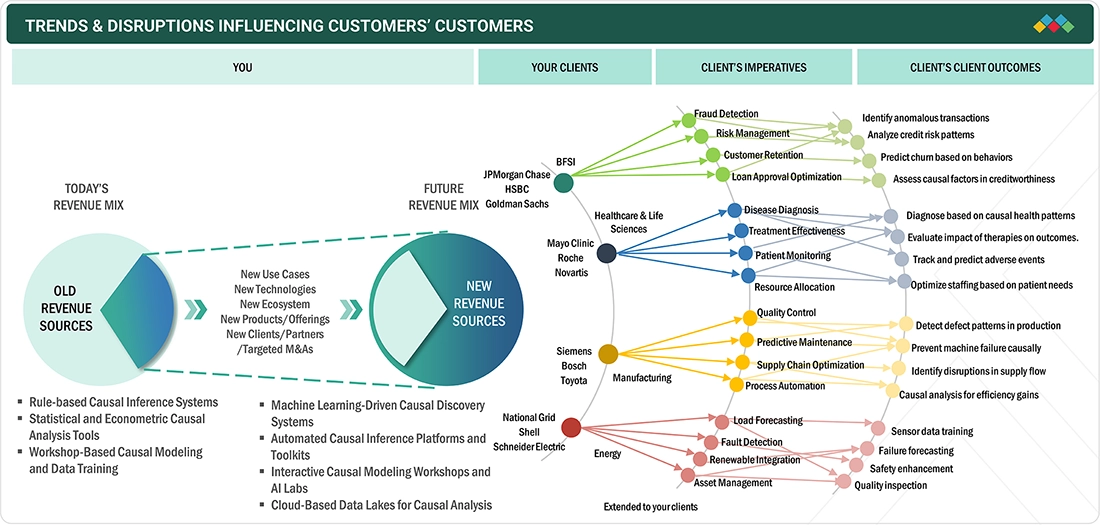
Source: Secondary Research, Interviews with Experts, MarketsandMarkets Analysis
MARKET DYNAMICS
Level
-
Rising demand for personalized solutions in marketing, customer engagement, and experience optimization

-
The shift from predictive analytics to causal AI-powered prescriptive analytics
Level
-
Dependence on high-quality, unbiased, and well-structured data
Level
-
Integration of causal inference models into supply chain systems is enabling critical decision-making
-
Development of scalable causal inference APIs is unlocking real-time applications
Level
-
Complexity of causal model development and interpretability
Source: Secondary Research, Interviews with Experts, MarketsandMarkets Analysis
Driver: Rising demand for personalized solutions in marketing, customer engagement, and experience optimization
The growing demand for personalized experiences is a key driver of Causal AI adoption. Unlike traditional AI, which relies on correlations, causal inference algorithms uncover why customers behave a certain way—enabling Dynamic content personalization, Targeted campaigns, and Individualized engagement strategies. With over 70% of consumers expecting tailored interactions, Causal AI empowers businesses to improve customer lifetime value, loyalty, and revenue performance.
Restraint:Dependence on high-quality, unbiased, and well-structured data
Causal AI requires structured, consistent, and unbiased datasets to accurately model cause-and-effect relationships. Incomplete or fragmented data can lead to Flawed insights, Suboptimal decisions, Reduced model reliability. Industries like healthcare and public policy, where data is often siloed or inconsistent, face significant barriers to adoption.
Opportunity: Integration of causal inference models into supply chain systems is enabling critical decision-making
Causal AI presents strong growth potential in supply chain management, enabling Scenario planning, Disruption prediction, Proactive risk mitigation. As global supply chains become more complex, causal reasoning frameworks offer real-time decision intelligence, cost optimization, and resilience-building capabilities.
Challenge: Complexity of causal model development and interpretability
Deploying causal AI requires specialized expertise in Statistical modeling, Counterfactual analysis, Causal discovery frameworks. Organizations face challenges due to talent shortages, resource constraints, and the need for expert guidance. Smaller enterprises and AI-nascent sectors struggle with adoption due to the technical depth and alignment requirements.
CAUSAL AI MARKET: COMMERCIAL USE CASES ACROSS INDUSTRIES
| COMPANY | USE CASE DESCRIPTION | BENEFITS |
|---|---|---|
 |
BMO Financial Group leveraged Dynatrace’s Grail technology and causal AI to gain real-time, explainable insights across hybrid cloud infrastructure, enhancing operational efficiency and innovation. | BMO achieved an 80% reduction in root-cause analysis time and freed up 40 hours per team monthly, enabling faster issue resolution and innovation. |
 |
Fingersoft adopted Incrmntal’s causal AI actionable insights to optimize marketing campaigns under privacy constraints, enabling scalable, data-driven decisions for improved performance and growth. | The company achieved continuous, privacy-compliant incrementality measurement, enhancing marketing decision-making and campaign ROI, supporting accelerated growth and more effective budget allocation. |
 |
A global electronics company implemented Causalens’ CausalNet causal AI to create explainable, domain-aligned fault detection models for reliable predictive maintenance across complex manufacturing processes. | The company reduced R&D cycle time, improved defect detection reliability, and deployed a generalized, extensible causal AI model adaptable across products for enhanced operational efficiency. |
 |
TRUMPF used Xplain Data’s causal AI to identify actionable cause-and-effect relationships in operational data, improving root-cause analysis and predictive equipment maintenance. | TRUMPF reduced equipment failure rates, automated scalable analyses, and improved predictive maintenance, enabling proactive interventions that strengthened operational efficiency and quality management. |
Logos and trademarks shown above are the property of their respective owners. Their use here is for informational and illustrative purposes only.
MARKET ECOSYSTEM
The causal AI ecosystem comprises key players offering platforms, tools, APIs, and services to enable organizations to leverage cause-and-effect insights. Major platform providers like causaLens, Causaly, and Aitia focus on comprehensive solutions. Tool providers, including Google and Microsoft, specialize in data-driven causal inference. API developers like DataRobot deliver integration-ready toolkits, while service providers such as IBM and Veldt offer customized implementation and advisory services. This ecosystem facilitates diverse applications across industries.
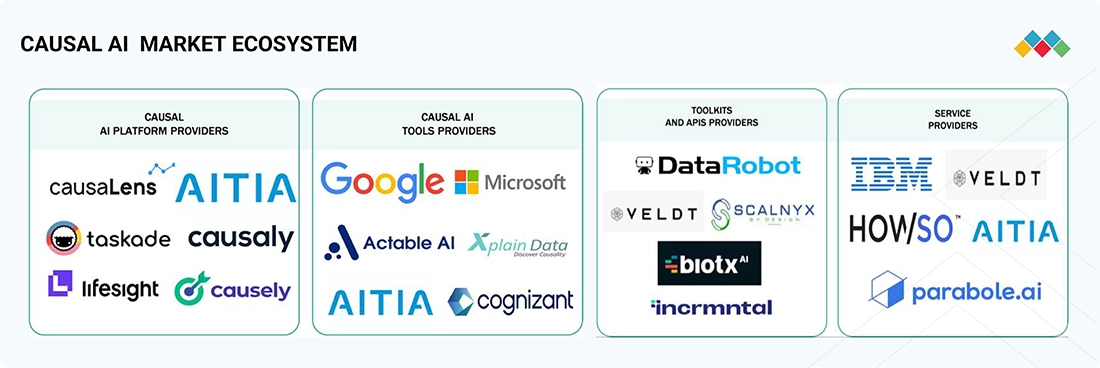
Logos and trademarks shown above are the property of their respective owners. Their use here is for informational and illustrative purposes only.
MARKET SEGMENTS
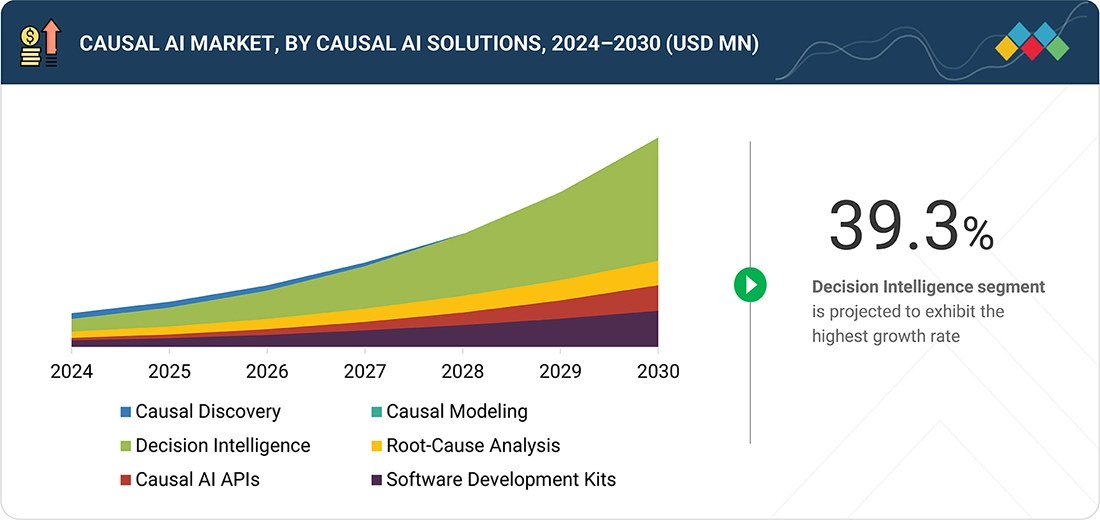
Source: Secondary Research, Interviews with Experts, MarketsandMarkets Analysis
Causal AI Market, By Causal AI Solution
The decision intelligence segment is the fastest-growing area in the Causal AI market. Enterprises are adopting platforms that combine Causal inference, Counterfactual analysis, and Predictive scenario modeling. These tools enable transparent, outcome-driven decision-making across strategic, operational, and risk domains. Vendors are embedding real-time causal reasoning and explainable AI frameworks to meet enterprise demand for accountable AI systems.
Causal AI Market, By Services
Training, support, and maintenance services are growing rapidly as organizations seek Expertise in causal model deployment, Help with data preparation and integration, and Ongoing platform optimization. Vendors are offering specialized onboarding, technical support, and skill development programs to close talent gaps and accelerate enterprise-scale adoption.
Causal AI Market, By Application
Marketing and pricing management is the fastest-growing application, driven by demand for Personalized campaigns, Dynamic pricing optimization, and Customer behavior modeling. Causal AI enables businesses to simulate campaign outcomes, optimize pricing strategies, and improve marketing ROI through cause-and-effect analysis.
Causal AI Market, By Vertical
The healthcare and life sciences vertical is leading growth due to adoption of Causal discovery frameworks, Digital twin simulations, and Predictive modeling for clinical trials and drug discovery. Causal AI helps uncover true cause-and-effect relationships in complex biological systems, enabling personalized medicine, treatment optimization, and operational efficiency.
REGION
Asia Pacific to be the fastest-growing region in the causal AI market during the forecast period
The Asia Pacific region is the fastest-growing market for Causal AI, driven by Government-backed AI research initiatives, Enterprise investments in data-driven decision-making, and Rising demand for outcome-focused, explainable analytics. Organizations across the region are rapidly adopting causal inference platforms, predictive modeling tools, and decision intelligence frameworks to improve strategic planning, risk management, and operational efficiency. For example, Hazy is enabling financial risk modeling in Singapore using causal AI frameworks to support regulatory compliance and precision forecasting, DarwinAI is supporting manufacturing optimization in Japan through causal discovery and predictive analytics, helping enterprises enhance process efficiency and reduce waste. These examples reflect Asia Pacific’s focus on market-specific, scalable, and transparent AI solutions tailored to local business needs and regulatory environments.
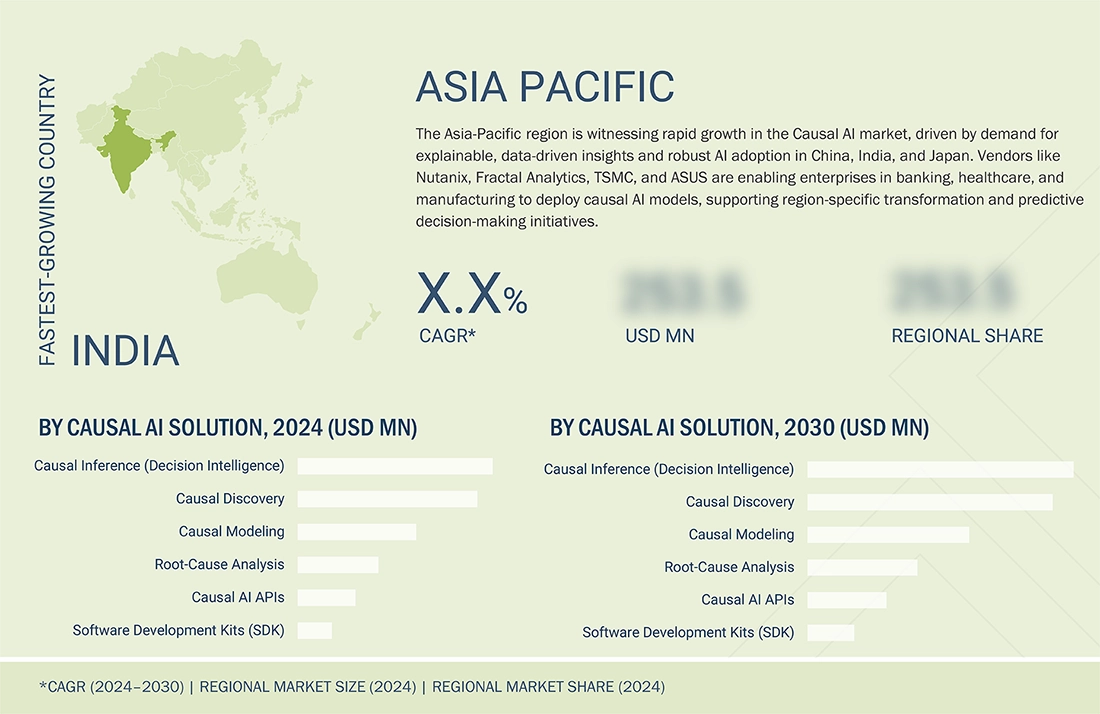
CAUSAL AI MARKET: COMPANY EVALUATION MATRIX
In the Causal AI market matrix, causaLens (Star) leads with a strong market footprint and an extensive portfolio of causal inference algorithms, predictive modeling tools, and AI governance capabilities. Its flagship Decision Intelligence Platform is driving large-scale adoption, enabling organizations to uncover cause-and-effect relationships, optimize business outcomes, and enhance model transparency. Aitia (Emerging Leader) is rapidly gaining traction with its causal discovery frameworks, digital twin-based simulations, and applications in pharmaceutical R&D and precision medicine. While causaLens sets the benchmark for scalability, interoperability, and enterprise integration, Aitia demonstrates strong growth potential, moving steadily toward the Star quadrant through innovation and domain-focused advancements.
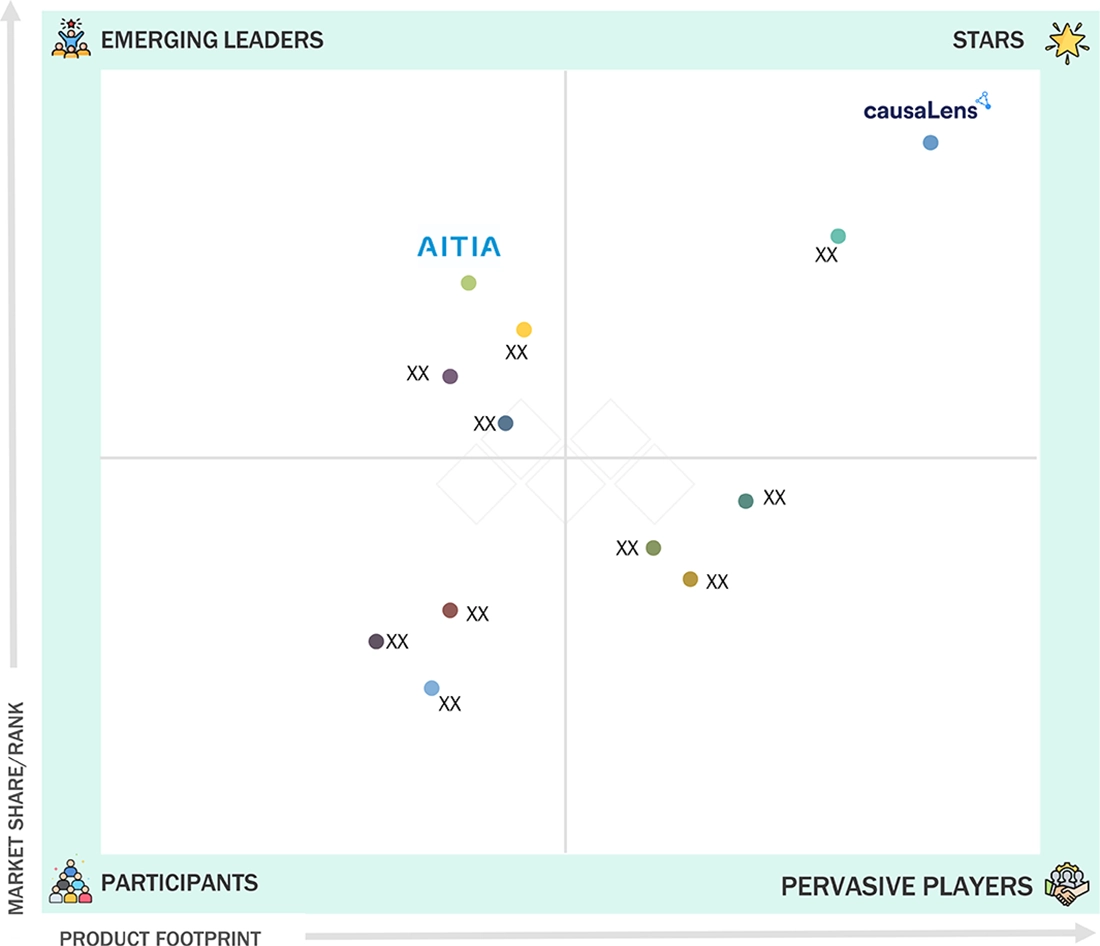
Source: Secondary Research, Interviews with Experts, MarketsandMarkets Analysis
KEY MARKET PLAYERS
- IBM (US)
- CausaLens (UK)
- Microsoft (US)
- Dynatrace (US)
- Causality Link (US)
- Cognizant (US)
- Logility (US)
- DataRobot (US)
- Google (US)
- Aitia (China)
- Causaly (UK)
- Data Poem (US)
- Lifesight (Singapore)
- Parabole.AI (US)
MARKET SCOPE
| REPORT METRIC | DETAILS |
|---|---|
| Market Size in 2023 (Value) | USD 41.34 MN |
| Market Forecast in 2030 | USD 456.88 Million |
| Growth Rate | CAGR of 41.8% during 2024-2030 |
| Years Considered | 2019-2030 |
| Base Year | 2023 |
| Forecast Period | 2024-2030 |
| Units Considered | Value (USD Million) |
| Report Coverage | Revenue forecast, company ranking, competitive landscape, growth factors, and trends |
| Segments Covered |
|
| Regions Covered | North America, Asia Pacific, Europe, the Middle East & Africa, and Latin America |
WHAT IS IN IT FOR YOU: CAUSAL AI MARKET REPORT CONTENT GUIDE
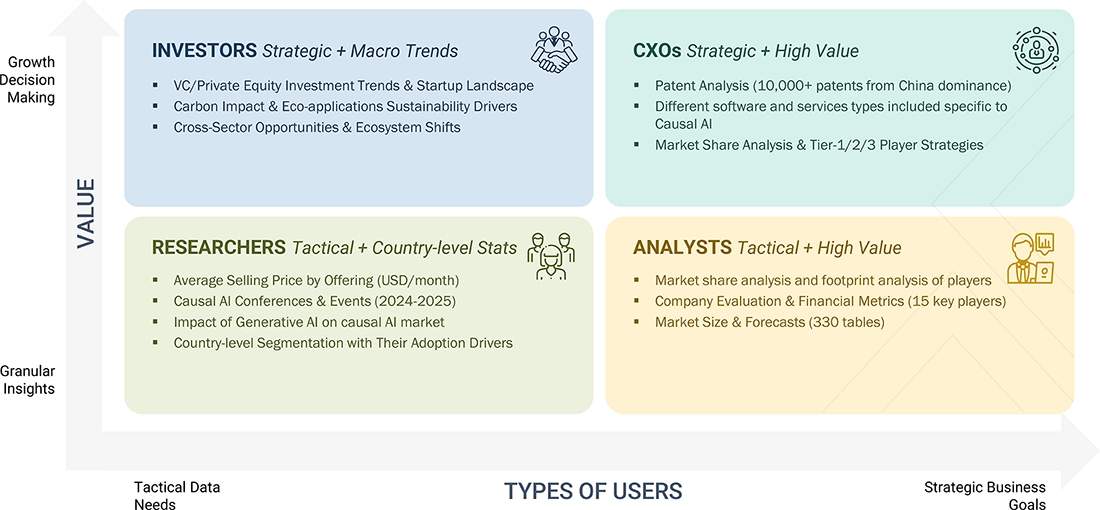
DELIVERED CUSTOMIZATIONS
We have successfully delivered the following deep-dive customizations:
| CLIENT REQUEST | CUSTOMIZATION DELIVERED | VALUE ADDS |
|---|---|---|
| Leading Solution Provider (US) | Delivered competitive profiling of additional vendors, brand comparative analysis, and a drill-down of country-level segmentation across key markets. | Enabled competitive positioning insights, product differentiation clarity, and multi-country market intelligence, supporting go-to-market strategy refinement and stakeholder alignment. |
| Leading Solution Provider (Europe) | Provided competitive profiling, brand benchmarking, and segmentation analysis across additional geographies. | Delivered in-depth market insights, comparative brand positioning, and segment-level intelligence, empowering strategic decision-making and regional growth planning. |
RECENT DEVELOPMENTS
- October 2024 : causaLens launched new enhancements in the AI agent’s platform. These enhancements facilitate improved decision-making by combining causal AI and large language models, enabling users to interpret complex data with accuracy and recommend optimal actions. This innovation provides businesses with faster, explainable insights into causal relationships in data for improved, data-driven strategies.
- September 2024 : Google Cloud and causaLens collaborated to integrate causaLens’ causal AI technology with Google Cloud’s generative AI and cloud capabilities. This partnership enables large language models (LLMs) to handle complex quantitative data with enhanced causal reasoning, supporting businesses in making data-driven, explainable decisions.
- September 2024 : Taskade enhanced its AI Causal Inference GPT Agent with the addition of Public AI Agents for easy sharing and deployment, one-click video calls, and automated tables with customizable fields for task management. These features aim to improve collaboration and efficiency, allowing users to seamlessly connect and automate workflows within their projects.
- September 2024 : Logility acquired Garvis to enhance its supply chain planning with AI-driven demand forecasting. The integration will combine generative AI and causal AI through DemandAI+, offering real-time, data-driven insights and reducing planning time. This acquisition aims to create a more agile and transparent supply chain system.
- April 2024 : IBM Instana introduced a new feature called Probable Root Cause as part of its Intelligent Incident Remediation capabilities. This feature uses causal AI to automatically analyze incidents by assessing call statistics and application topology, enabling faster identification of the root cause of issues.
Table of Contents

Methodology
The research methodology for the global Causal AI market report involved the use of extensive secondary sources and directories, as well as various reputed open-source databases, to identify and collect information useful for this technical and market-oriented study. In-depth interviews were conducted with various primary respondents, including key opinion leaders, subject matter experts on causal inference, causal modelling and causal discovery, high-level executives of multiple companies offering Causal AI, and industry consultants to obtain and verify critical qualitative and quantitative information and assess the market prospects and industry trends.
Secondary Research
In the secondary research process, various secondary sources were referred to for identifying and collecting information for the study. The secondary sources included annual reports; press releases and investor presentations of companies; white papers, certified publications such as Journal of Big Data, Journal of Artificial Intelligence Research, Data & Knowledge Engineering (DKE) Journal, Big Data and Cognitive Computing Journal, International Journal of Data Science and Analytics, and International Journal of Advances in Intelligent Informatics; and articles from recognized associations and government publishing sources including but not limited to AI Global, Global Initiative on Ethics of Autonomous and Intelligent Systems, Global Partnership on Artificial Intelligence, The Responsible AI Institute, European AI Alliance, AI for Good (United Nations), and World Economic Forum’s Whitepaper on Future of Mobility and Big Data.
The secondary research was used to obtain key information about the industry’s value chain, the market’s monetary chain, the overall pool of key players, market classification and segmentation according to industry trends to the bottom-most level, regional markets, and key developments from the market and technology-oriented perspectives.
Primary Research
In the primary research process, a diverse range of stakeholders from both the supply and demand sides of the Causal AI ecosystem were interviewed to gather qualitative and quantitative insights specific to this market. From the supply side, key industry experts, such as chief executive officers (CEOs), vice presidents (VPs), marketing directors, technology & innovation directors, as well as technical leads from vendors offering Causal AI were consulted. Additionally, system integrators, service providers, and IT service firms that implement and support Causal AIs were included in the study. On the demand side, input from IT decision-makers, infrastructure managers, and AI/data analytics heads was collected to understand the user perspectives and adoption challenges within targeted industries.
The primary research ensured that all crucial parameters affecting the Causal AI market—from technological advancements and evolving use cases (financial management, marketing & pricing management, operations & supply chain management, etc.) to regulatory and compliance needs (GDPR, EU AI Act, California Consumer Privacy Act etc.)—were considered. Each factor was thoroughly analyzed, verified through primary research, and evaluated to obtain precise quantitative and qualitative data for this market.
Once the initial phase of market engineering was completed, including detailed calculations for market statistics, segment-specific growth forecasts, and data triangulation, an additional round of primary research was undertaken. This step was crucial for refining and validating critical data points, such as Causal AI offerings (causal AI platforms, causal discovery tools, causal modelling tools, causal inference tools, root cause analysis tools, and causal AI services), industry adoption trends, the competitive landscape, and key market dynamics like demand drivers (increasing demand for explainable AI in regulated industries, growing demand for robust counterfactual analysis, surge in demand for predictive maintenance and root cause analysis, shift from predictive analytics to causal AI-based prescriptive analytics), challenges (lack of standardized tools and frameworks for causal inference, high computational costs for causal modeling), and opportunities (Causal AI in precision healthcare and drug discovery, scalable causal inference APIs for real-time applications, integrating causal AI with IoT for real-time decision making.)
In the complete market engineering process, the top-down and bottom-up approaches and several data triangulation methods were extensively used to perform the market estimation and market forecast for the overall market segments and subsegments listed in this report. Extensive qualitative and quantitative analysis was performed on the complete market engineering process to record the critical information/insights throughout the report.
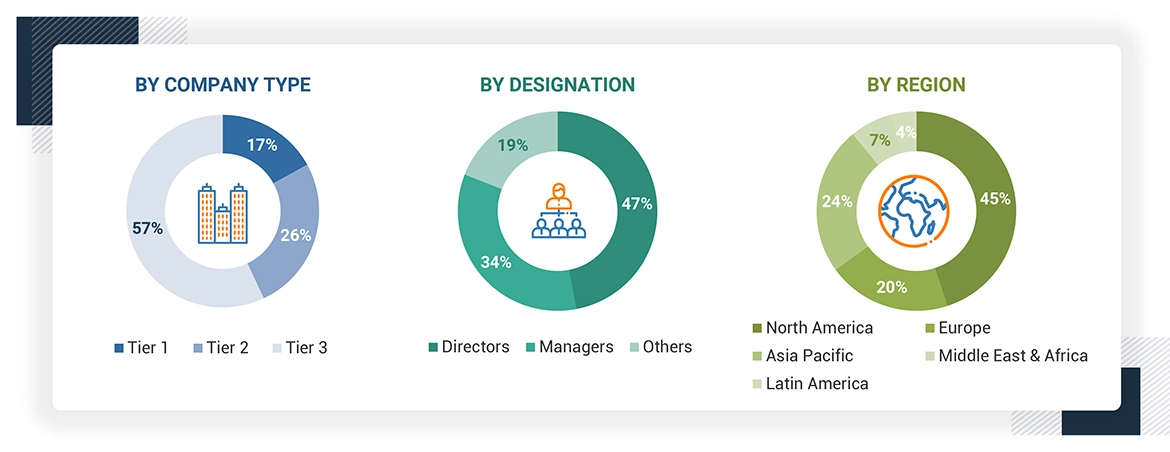
Note: Three tiers of companies are defined based on their total revenue as of 2023; tier 1 = revenue more
than USD 500 million, tier 2 = revenue between USD 100 million and 500 million, tier 3 = revenue less
than USD 100 million Source: MarketsandMarkets Analysis
To know about the assumptions considered for the study, download the pdf brochure
Market Size Estimation
To estimate and forecast the Causal AI market and its dependent submarkets, both top-down and bottom-up approaches were employed. This multi-layered analysis was further reinforced through data triangulation, incorporating both primary and secondary research inputs. The market figures were also validated against the existing MarketsandMarkets repository for accuracy. The following research methodology has been used to estimate the market size:
Causal AI Market : Top-Down and Bottom-Up Approach
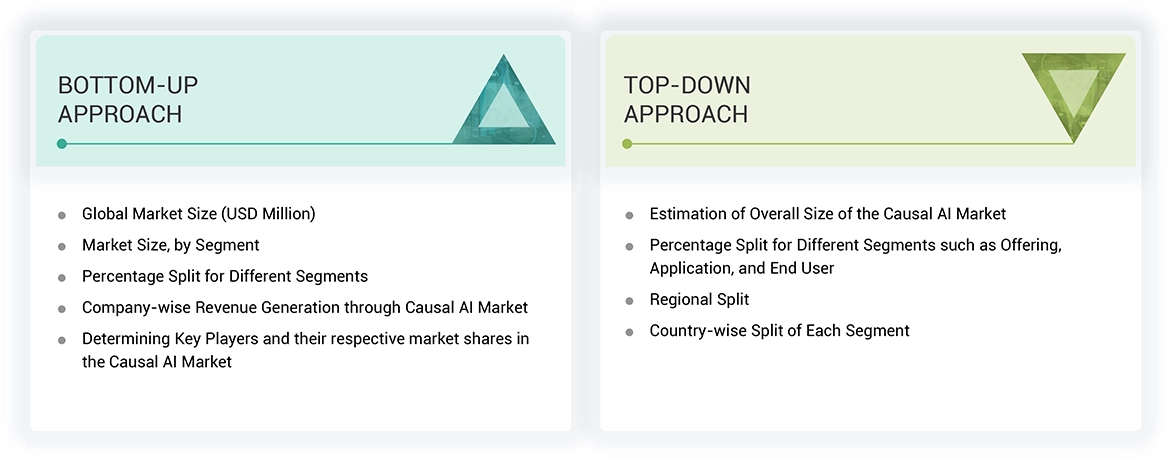
Data Triangulation
After arriving at the overall market size using the market size estimation processes as explained above, the market was split into several segments and subsegments. To complete the overall market engineering process and arrive at the exact statistics of each market segment and subsegment, data triangulation and market breakup procedures were employed, wherever applicable. The overall market size was then used in the top-down procedure to estimate the size of other individual markets via percentage splits of the market segmentation.
Market Definition
Causal AI focuses on understanding and modeling cause-and-effect relationships within data to move beyond correlation-based predictions. By employing techniques like causal discovery, intervention analysis, and counterfactual reasoning, it enables AI systems to simulate interventions, predict outcomes, and make robust, explainable decisions even in novel or shifting environments. Rooted in principles of causal inference and structural causal models, Causal AI enhances generalization, fairness, and transparency while providing actionable insights. It has wide-ranging applications in healthcare, finance, marketing, and AI ethics to create adaptive and trustworthy AI systems.
Stakeholders
- Causal AI platform vendors
- Root cause analysis software vendors
- Causal AI service providers
- Causal inferencing software providers
- Causal discovery software providers
- Causal modelling software providers
- Business analysts
- Cloud service providers
- Enterprise end-users
- Distributors and Value-added Resellers (VARs)
- Government agencies
- Independent Software Vendors (ISV)
- Market research and consulting firms
- AI technology providers
Report Objectives
- To define, describe, and predict the Causal AI market by offering, application, and region
- To provide detailed information related to major factors (drivers, restraints, opportunities, and industry-specific challenges) influencing the market growth
- To analyze the micro markets with respect to individual growth trends, prospects, and their contribution to the total market
- To analyze the opportunities in the market for stakeholders by identifying the high-growth segments of the Causal AI market
- To analyze opportunities in the market and provide details of the competitive landscape for stakeholders and market leaders
- To forecast the market size of segments for five main regions: North America, Europe, Asia Pacific, Middle East Africa, and Latin America
- To profile key players and comprehensively analyze their market rankings and core competencies.
- To analyze competitive developments, such as partnerships, new product launches, and mergers and acquisitions, in the Causal AI market
- To analyze the impact of recession across all the regions across the Causal AI market
Available Customizations
With the given market data, MarketsandMarkets offers customizations as per the company’s specific needs. The following customization options are available for the report:
Product Analysis
- Product matrix provides a detailed comparison of the product portfolio of each company
Geographic Analysis as per Feasibility
- Further breakup of the North American market for Causal AI
- Further breakup of the European market for Causal AI
- Further breakup of the Asia Pacific market for Causal AI
- Further breakup of the Latin American market for Causal AI
- Further breakup of the Middle East & Africa market for Causal AI
Company Information
- Detailed analysis and profiling of additional market players (up to five)
Need a Tailored Report?
Customize this report to your needs
Get 10% FREE Customization
Customize This ReportPersonalize This Research
- Triangulate with your Own Data
- Get Data as per your Format and Definition
- Gain a Deeper Dive on a Specific Application, Geography, Customer or Competitor
- Any level of Personalization
Let Us Help You
- What are the Known and Unknown Adjacencies Impacting the Causal AI Market
- What will your New Revenue Sources be?
- Who will be your Top Customer; what will make them switch?
- Defend your Market Share or Win Competitors
- Get a Scorecard for Target Partners
Custom Market Research Services
We Will Customise The Research For You, In Case The Report Listed Above Does Not Meet With Your Requirements
Get 10% Free Customisation












Growth opportunities and latent adjacency in Causal AI Market